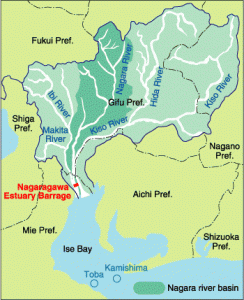Japanese Giant Fish, Part 6- Phantom Giant Rays
Posted by: mystery_man on July 10th, 2010
Phantom Giant Rays
The Nagara River of Gifu prefecture, Japan, has been the source of several sightings of what appear to be giant, river going rays.
The first report surfaced in 1986 in Hashima City, Gifu, where an eyewitness described seeing a ray-like fish with “wings.” The mysterious fish was estimated as being 2 meters (6.6 feet) long and 1 meter (3.2 feet) wide from wingtip to wingtip. It was said to appear to be “flying” through the water. Although only the silhouette of the creature was seen, the witness, a long time resident of the area, said the shape of the creature was very much like that of a ray and unlike anything he had ever seen in the river before.
A few other sightings of the mysterious fish have popped up over the years, all describing the same distinctive “winged” shape of the original sighting.
This strange creature could be a ray that has travelled inland from the sea, although this would be very unusual for a saltwater fish of this type to do. There are freshwater rays however Japan has no known native species like this.
Nevertheless some of the largest rays in the world are freshwater species. The Mekong River giant freshwater stingray of Southeast Asia can be 5 meters (16.4 feet) long and up to a whopping 600 kg (1,300 lbs). Could there be some similar type of large, freshwater ray remaining undiscovered in Japan?
Another possibility is that perhaps a Pacific halibut (Hippoglossus stendepis) somehow made its way inland from the sea. The shape of a halibut could certainly be seen as being somewhat ray-like, and these fish are known in Japanese waters. They can also get huge, with some specimens reported as being over 8 feet long and over 700 lbs.
The problem with this hypothesis is that halibut are not known to venture into freshwater, and would probably not survive long if they did. In addition, the older, larger individuals prefer deep water where they would be more unlikely to find their way into a river to begin with.
There are only a small handful of sightings of this enigmatic river creature, so it seems likely we may never know for sure.
About mystery_man













It should be noted that the upper states if size and weight for the giant Asian freshwater rays are – after all – still somewhat obscure. It seems for example that NONE of the big specimens was actually ever weighed, and all data of the actual weights are merely estimations. In any case, this are huge animals of course. It is also sometimes problematic to find really accurate data about their lengths. Very often only the diameter of the disk is given, but they have a very long tail too. One problem is that the tail can be often incomplete or even missing if the ray had any accidents during its (early) life. There are undisputed records of such rays which had a disk diameter of more than 2 m, I only wanted to note that the claims of specimens of much larger dimensions which are sometimes given, are highly dubious.
Very interesting. Thanks for that enlightening bit of natural and cultural history.
These kinds of insights always cause me to ponder about the state of the natural world prior to our more modern focus and application of haversting methods in gathering so much of the marine inventory of species. I wonder if the Japanese as they become more aware of human impacts on their coastal fisheries, if they might not embrace the practices they’ve long exercised on their forests, and come to a point where fishing is managed so as not to disrupt, and actually restore the natural patterns of productivity upon which a healthy system depends and upon which the japanese in particular have benefitted for so long. We have, I hope, at long last, left that age of human perception of the wild as being an inexhaustible source of free rent intended for our unlimited use. The oceans, and particular the coastal regions, are just now falling under the modern management regimes, and in other areas, marine preserves, that had been particularly hard hit in the past, have shown a remarkable degree of reslience if left to recupperate, in which case we might one day see a return of the largest and most conspicuous species to their original ranges.
First, MM, thanks for another cool article. As I’ve said cryptids in Japan has been most interesting and I’ve enjoyed every article!
As for the rays, I suppose it is possible–with a relation to sharks, it is a possibility that rays may have the same capability to shift from salt to fresh water environments like the bull and the greenland shark (I’ll give MQ credit for knowing that info). Stranger possibilities exist.
Either that or there’s a bottom dwelling fresh water ray that only sparingly comes up…do you know roughly how deep the river is? I see from Wikipedia that it is a clear flowing river…which might account for being able to see a ray coming off the bottom.
Dogu4- The problem with Japan is that they have been a little slow to adapt the idea of sustainable fisheries. One can see this demonstrated by the unhindered overfishing of tuna and the spectacular drop in numbers of other species as well due to overfishing. For instance, sturgeon are thought to be perhaps extinct in Hokkaido and the taimen is nearly so due at least in part to rampant overfishing.
The fisheries in Japan face several hurdles. One is the pervasivness of invasive species that have been introduced either as food fish or for sportfishing. Invasive fish such as largemouth bass, bluegill, and rainbow trout, have all caused quite a bit of damage to the environment and native species in the places where they have gained a foothold in Japan.
Another problem is that over 90% of Japanese rivers and waterways are dammed to some extent, which has created problems for species such as eel and salmon. Only recently have measures been taken to try and stem the damage caused by these factors, but it seems too little too late if you ask me.
Springheeledjack- The thing is that very few fish, only around 2% of all known species, can tolerate wide ranges of salinity to the point that they can move bewteen freshwater and saltwater.
The challenge is related to osmotic pressure between the fishes internal environment and the outside environment. So a freshwater fish that finds itself in saltwater has to contend with losing vast amounts of water through osmosis to the seawater and a saltwater fish in freshwater has to contend with a crippling influx of excess water from the environment. Many, many species of fish are what we know of as stenohaline fish, which means they are specifically adapted to a certain, narrow range of salinity.
There are fish that can handle thes large ranges of salinity involved in going from saltwater to freshwater. For instance the bull sharks are a well known example, as are some other species of shark and what are known as euryhalin fish, which are fish that can tolerate fluctuations of salinity at some stage in their lifecycle, such as salmon or eels. The things is, these species have evolved special biological mechanisms for dealing with the absorption or excretion of salt and water that takes place when moving between the two environments.
So for instance with the bull shark, we have essentially a saltwater fish moving to freshwater. This move to freshwater forces the fish to have to deal with replacing salts and eliminating excess water due to osmotic pressure. This is mostly done through ejecting the water out of the body through urea, which places incredible demands on the kidneys. This would kill most fish, but the bull shark has certain physical adaptations to overcome this challenge. The same goes for the salmon and eels I mentioned or for the Greenland shark you mentioned. Without these adaptations to deal with the challenges presented by osmosis, most fish species will die in the new environment in short order. It also must be rememberted that even in these cases where there are such adaptations, the change from saltwater to freshwater or vice versa is typically gradual.
There are instances of saltwater fish adapting completely to freshwater. For instance you have stingrays in the Amazon, sharks, rays and other saltwater type fishes in Lake Nicaragua, even freshwater sardines in Taal Lake of the Phillipines. With these species, there has typically been some event such as rising or falling sea levels, volcanic eruptions, and so on, which have geographically isolated the species or gradually lowered the salinity levels of the environment over time and therefore caused them to evolve into the new habitat. In these cases, the fish have developed the ability to cope in freshwater over millions of years of evolution.
So, in short, I do think that a new type of freshwater ray could be the case here. However, it would not be so simple as saying a ray from the ocean managed to find its way up the river and somehow adapted to deal with the problems of osmotic pressure. It would need special physical adaptations developed over time, such as those displayed by the bull shark. If we are dealing with a ray travelling from saltwater to freshwater, then in that case we are still dealing with a new species capable of doing so with these Japanese mystery rays.
So not just any ray is going to be able to go from salwater to freshwater for any appreciable length of time. We would have to be dealing with something pretty unique here.
Anyway, thanks for the comments and I’m glad this was enjoyed.